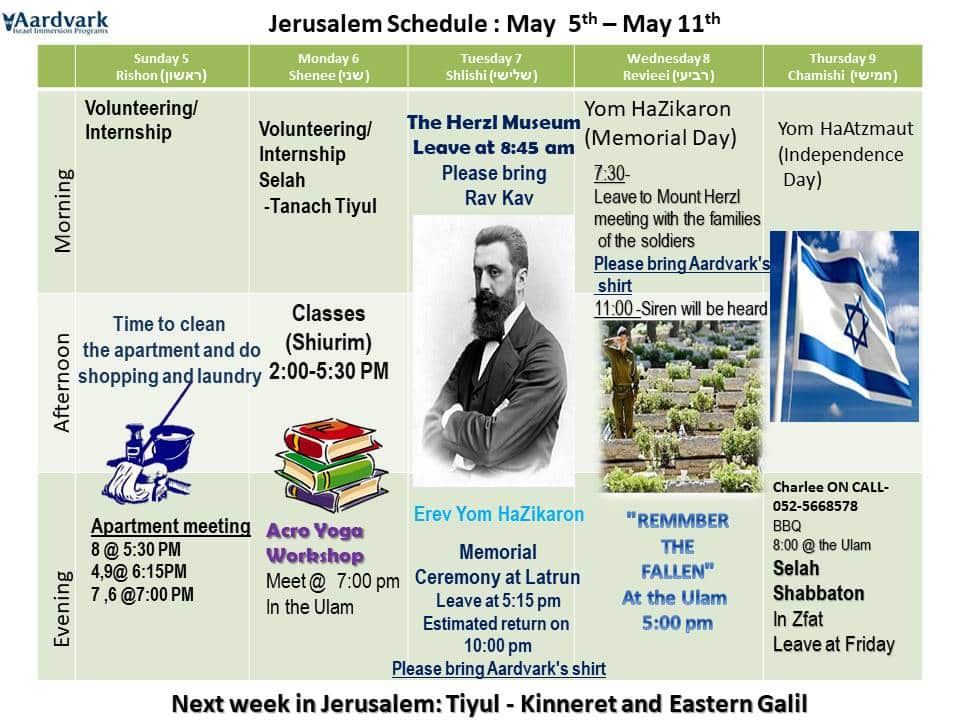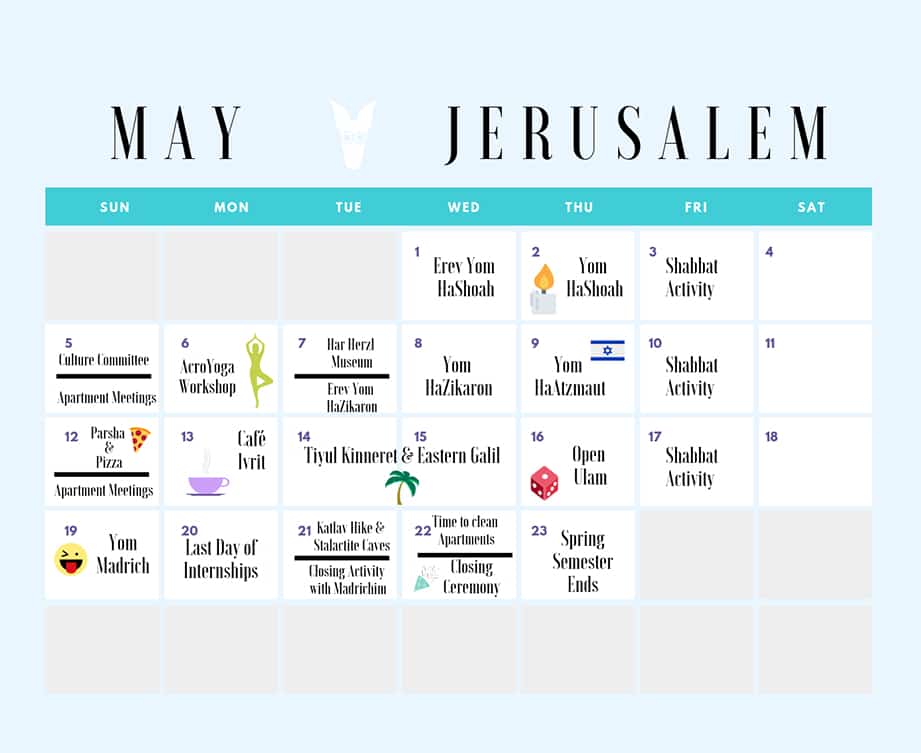Shalom Parents!
We hope everyone had a wonderful Passover holiday! This week in Jerusalem, it was great to hear from all of the students about their adventures and celebrations during the time off. We had a very busy week, with so much going on! This time of year in Israel is always an exciting one with a holiday or special day nearly every week for a month…
On Sunday evening at the apartment meetings, the students learned about “Sfirat Ha’Omer”. The Omer is counted every evening after nightfall, from the second night of Passover until the night before Shavuot. The students learned that when counting the Omer they count ‘three days until Shavuot, four days until Shavuot, five days until Shavuot, etc’, and when they countdown to something exciting like a birthday for example, they count ‘two weeks until my birthday, one week until my birthday, five days until, etc’.
The students along with Shalhevet the Madricha, discussed it being the last month of the program and how time is moving too fast and what do they, the students, still want to accomplish in the time they have left in Aardvark. Some of the students had the idea to create ‘Bucket Lists’ for this last month so they can accomplish all the things they set out to do.
On Monday night, we had a sushi workshop in which we taught the students how to make sushi. For many of us it was our first time making sushi, and we can now add it to our growing repertoire of foods we can now make. “I just love seaweed and avocado, and for me to put seaweed with rice, fish and avocado is amazing, because I love avocado! And it is so easy to make, and so easy to eat. I even heard it’s quite healthy too!” said Shira Vilvovsky
On Tuesday morning, the students had the honor of spending the morning visiting the Scroll of Fire and learning about the Holocaust.
Located in what is the single largest memorial to the Holocaust in the world, the Martyrs Forest, The Scroll of Fire is an imposing work rich in detail and history – it tells the story of the rebirth of the nation from the Holocaust up to the Six Day War. The sculpture commands a spectacular view of its surroundings. The students started by walking around the giant scroll and identifying each of the themes on it. Then, each student was asked to define what the Holocaust and Israel meant to them in just one word.
Afterwards everyone went for a hike in The Martyrs Forest.
The Martyrs Forest is comprised of six million trees – truly, a living memorial. Four and half million pine trees represent the adults who perished in the Holocaust while one and a half million cypress trees represent the children who perished.
After walking for some time, and taking in the flowers blossoming along our trail, the students stopped and with the help of their tour guide Talya Dvir, made tea from herbs and flowers. While the tea was boiling, the students were given love stories from the Holocaust to read and then share with the group. It was a really beautiful way to see that there was love and hope in such a dark time in our History.
On Tuesday evening, we had the privilege to have the student Dana Bederson teach us the Parsha for this week’s Parsha & Laffa!
Dana said, “Tonight was the second time I had the honour of Parsha and Laffa. We spoke about this week’s Torah portion Acharei Mot and next week’s portion Kedoshim. I personally feel that I learn best when we discuss and answer questions, so I gave a small summary of the Parsha and I decided to discuss the theme of Holiness. What makes you feel holy and how we can fulfill the commandments.
After writing, we discussed our answers and it was a good way to share and bounce around ideas and add to each other’s feelings and thoughts. I love educating others, and it’s a blessing! Thanks Aardvark!”
On Wednesday night, we joined the Tel Aviv group for a lecture from a man called Pavel Batel. Pavel is a Terezin guide, historian and writer. He survived a violent childhood in communist Czechoslovakia. In the chaotic post-communist period, he graduated from a military academy, and then entered the world of elite protection services, where he often had to save his clients from the kind of violence they were inflicting upon others. In a surprising turns of events, Pavel discovered and identified with his Jewish roots during a visit to the Terezin concentration camp. This opened his eyes to the problems of ethnic bigotry, and he vowed to do his part in opposing the nationalist groups that were growing to prominence in the former eastern bloc countries in the 1990s.
He spoke with us about Terezin, a garrison town built in the late 1700’s and later converted into a concentration camp and Jewish ghetto during the Holocaust. Although the camp was used as a transit camp and not as an extermination camp, tens of thousands of people died there in any event. Some were killed outright, and others died from malnutrition and disease due to the cramped living quarters, lack of hygiene and medication, scarcity of food, improper heating, and other horrendous conditions.
Pavel also taught us about his childhood hero, Fredy Hirsch. Fredy was a German Jewish athlete, sports teacher and Zionist youth movement leader, notable for helping thousands of Jewish children during the German occupation of Czechoslovakia in Prague, Theresienstadt concentration camp, and Auschwitz. Hirsch was the deputy supervisor of children at Theresienstadt and the supervisor of the children’s block at the Theresienstadt family camp at Auschwitz II-Birkenau.
Because of his German extraction, charisma, and careful appearance, he was able to convince SS guards to grant privileges to the children, including exemptions from deportation and extra rations, which saved their lives at least temporarily. Hirsch and his assistants maintained clandestine education under the difficult circumstances. Hirsch’s insistence on exercise, discipline, and strict hygiene reduced death rates among the children.
Pavel’s insightful, highly knowledgeable and sensitive approach to the complex history really brought the story of Fredy and Terezin to life. What a memorable way to start Yom Hashoah in Israel.
On Thursday, both the Jerusalem and Tel Aviv students were honored to attend a Masa event for Yom Hashoah at the education center at Yad V’shem along with hundreds of gap year students from various Masa programs. We began the day with activities run by Yad Vashem’s own guides and educators. The focus of the day was the liberation of the Jews from the concentration camps and life in the immediate aftermath of the war. Images were spread across the floor, the students had to choose a picture and talk about the dilemmas it raised. It really helped us understand the chronology of the end of the war and the struggles of the survivors to adjust. We had a short tour around the grounds of the museum to learn the story of Israel’s efforts to preserve the memory of the Shoah. In the early years of the State of Israel, it was common to talk about the number six million and so most of the memorials and sculptures are immense, large and anonymous. In contrast, today it is more common to preserve the memory of the individual. We stopped in the art museum located in Yad Vashem. The Museum of Holocaust Art, inaugurated in 2005, is located in Yad Vashem’s Square of Hope. The Museum’s rotating permanent exhibition displays some 120 works of art. Most of these works were created during the Holocaust itself, or before the war by artists later murdered during the Shoah. Many of the works of art on display were created in ghettos, camps, forests, and while in hiding. They depict the reality of life during the Holocaust, but at the same time provide a glimpse into the inner world of the artist. Despite the appalling conditions and the daily struggle to survive, the artists inventively overcame their lack of materials. Through their creativity, they reasserted their individuality and their will to live.
After the walking tour, we were privileged to meet two survivors who told us their personal experiences of the Shoah as well as the stories of their Aliyah to Israel. Both were so proud to be Jewish and their passion for Israel and their hope for the Jewish people was mind-blowing. With so few survivors left today, it was a privilege and honor for us to hear these survivors tell us their stories.
The day ended with a memorial ceremony in the Hall of Remembrance which included wreath-laying, candle lighting, saying the Kaddish and memorial prayers. We then sang HaTikvah and we all felt a sense of pride to be able to sing the Israeli national anthem in our Jewish State, something many unfortunately never had the chance to do.
Internship in the Spotlight: Hi, my name is Sam Leopold, and I’m Ori Tepper, and together we work hard at the Gazelle Valley, where we take care of the habitat and help the reserve. A large portion of our day consists of taking care of a special gazelle named Johanna. She is very friendly but cannot be touched because the reserve is trying to rehabilitate her to get back into the wild. We love what we do and happy that we have this opportunity to volunteer here and help the environment.
Next week, we will be kicking off a special project we are participating in. The Ten Days of Gratitude, created by participants of the Ein Prat Mechina (a pre-army program for Israelis), is a time when we weave the days from Yom Ha’Shoah to Yom Ha’atzmaut together with a thread of gratitude. Amidst our national sorrow, we also appreciate the gift of sovereignty. The Ten Days of Gratitude provides us with a chance to appreciate and give thanks for the accomplishments, achievements and successes of our nation, integrating gratitude into our way of being for this period of national reflection.
All the Best,
Natali



















